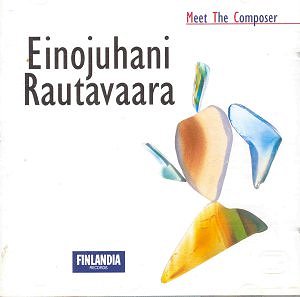Rautavaara
can be quite forbidding at times. Over the years his compositional
fealty has migrated from temple to temple and now moves with ease
from one idiom to another in the same work. Cantus Arcticus
represents the composer at his most welcoming. The work is in
three movements in which the sound of a string orchestra with
a small complement of woodwind is woven with taped birdcalls.
The recordings were made by the composer amid the bogland of Liminka
near Oulo. Rautavaara is a keen birdwatcher. The music has the
closest links at times to Sibelius's open air loyalties. The movements
are: The Bog; Melancholy and Swans Migrating.
The ecstatic sense of streaming writing and of great flocks of
birds flying over the listener's head is memorable.
The
Double Bass Concerto is dedicated to Olga Koussevitsky.
It is the centre panel of his Angel trilogy: flanked by Angels
and Visitations (overture) and Symphony No. 5 originally titled
Monologue with Angels. This is a more challenging work
than Cantus with all sorts of avant-garde effects including
wooden tapping and strange broken calls and shrieks wrung from
the solo instrument. Even so both the outer movements have strongly,
almost prayerlike, lyrical material. Olli Kosonen who played the
solo in the premiere is the also the soloist here.
The
Second Quartet is a product of the composer's long dalliance
with dodecaphony. It was written while he was alone in Köln
in 1958. It is in four movements musingly cradled, moonlit, wandering
and impetuous. Schoenberg and Bartok bustle their ways through
this music.
The
first two of the Cantos are products of the composer's
twelve tone period. The first is a string orchestra arrangement
of the overture to the three act opera Kaivos (The Mine)
written between 1957 and 1963. The work was inspired by the Hungarian
uprising in 1956. This is searing and probing music fusing Pettersson
and Bartók. As the booklet writer notes Canto II
is almost late-romantic in its dark glow - Mahlerian at
times. 'Canto' is a title borrowed from Ezra Pound. There are
seemingly no other links. There are two more Cantos but of these
only the third in the sequence is here. It dates from the period
when Rautavaara had put aside things dodecaphonic and embraced
the romantic. Listen out for cross-references with Cantus Arcticus.
Then
come the three composer tributes for string orchestra. The Bartók
was initially for cello and piano (1955). It reflects on a
smaller scale the Kodaly Hommage. Both are works by which
to warm the cockles of the heart. The Bartók is warmer
and more comforting than anything by Bartók himself. The
Kodaly is of tougher fibre with aleatorics, romantic textures
and high cyclical slaloming from the violins as in Hovhaness's
Fra Angelico overture. The Liszt is closer to the
Bartok Epitaph with rolling waves of baritonal string sound.
That other searing voice of the 20th century, Shostakovich, is
completely absent from Rautavaara's landscape.
A
Requiem in our Time is for brass ensemble. It is in four
strange and brief movements none longer that three minutes. Much
of this music depends on contrasts of dynamic and virtuoso playing
is required to achieve speed and pianissimo layering. This is
from Rautavaara's neo-classical period. The Requiem won
the Thor Johnson prize in Cincinnati in 1954.
The
notes tell us that the Sonetto was written for Martin
Fagerlund in 1969 and that the work inhabits the composer's Neo-Romantic
period. In fact there is a plainly unapologetic devotion to Bergian
principles. Its romance must be buried deep.
Finlandia
have not laid claims to this series providing a representative
sampling. This instead is Finlandia's Rautavaara archive ransacked
to create a generous selection. The Cantus, Bartók
Epitaph, Canto II and Liszt Hommage are the
highlights.
Rob
Barnett
